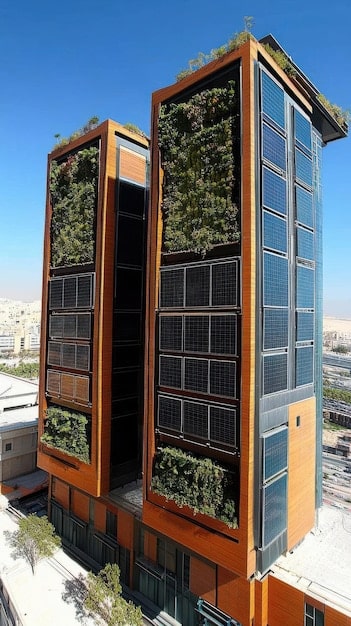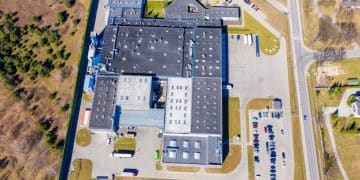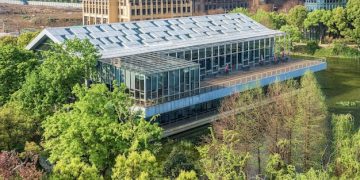US Green Building Revolution: LEED v5 and Energy Savings in Construction

The US Green Building Revolution is witnessing a significant shift with LEED v5, pushing commercial construction towards greater sustainability and achieving up to 15% energy savings through innovative green technologies and practices.
The US Green Building Revolution: How LEED v5 is Transforming Commercial Construction with 15% Energy Savings. Dive into how LEED v5 is reshaping commercial construction in the US, creating a more sustainable and efficient built environment.
The Dawn of LEED v5: Setting a New Standard in Green Building
LEED (Leadership in Energy and Environmental Design) has long been a benchmark for green building practices. Now, LEED v5 is poised to elevate that standard, driving innovation and sustainability across the US commercial construction landscape. Understand the core principles and objectives behind LEED v5, and how it surpasses previous versions in promoting environmental responsibility.
What’s New in LEED v5?
LEED v5 introduces several key updates and improvements over previous versions, focusing on enhanced performance metrics and a more holistic approach to sustainability. These changes aim to address emerging challenges and opportunities in the green building sector.
- Focus on Carbon Reduction: LEED v5 places a greater emphasis on reducing carbon emissions throughout the building lifecycle, from construction to operation.
- Enhanced Water Efficiency: The new version includes stricter requirements for water conservation, encouraging the use of innovative technologies and practices.
- Improved Indoor Environmental Quality: LEED v5 prioritizes the health and well-being of building occupants, with enhanced standards for air quality, lighting, and acoustics.
- Lifecycle Thinking: Encourages a holistic view, considering the environmental impact of materials and processes throughout the building’s entire lifespan.

The Impact on Construction Practices
The adoption of LEED v5 is driving significant changes in construction practices. Builders are now required to embrace more sustainable materials, implement more efficient energy systems, and prioritize waste reduction throughout the construction process.
LEED v5 encourages architects and engineers to think beyond traditional building methods and explore innovative solutions that minimize environmental impact. This includes the adoption of modular construction, prefabricated components, and other techniques that reduce waste and improve efficiency.
LEED v5 will affect every aspect of commercial construction, creating a new era of environmentally conscious building practices.
Achieving 15% Energy Savings: Key Strategies
One of the most significant goals of LEED v5 is to achieve a 15% reduction in energy consumption compared to baseline building performance. This ambitious target requires the implementation of advanced technologies and strategies across various aspects of building design and operation. Explore how these energy-saving strategies include advanced building systems, smart technologies, and sustainable design practices.
High-Performance Building Envelopes
A well-designed building envelope is crucial for minimizing energy loss and maintaining a comfortable indoor environment. LEED v5 encourages the use of high-performance insulation, energy-efficient windows, and airtight construction techniques.
Creating efficient envelopes and prioritizing natural ventilation will reduce the need for artificial climate control, driving down overall energy consumption and costs.
Smart Building Technologies
Smart building technologies play a vital role in optimizing energy performance. These systems use sensors, data analytics, and automation to monitor and control various building functions, such as lighting, HVAC, and security.
- Automated Lighting Controls: Adjust lighting levels based on occupancy and daylight availability.
- Advanced HVAC Systems: Optimize heating and cooling based on real-time conditions.
- Energy Monitoring and Management: Track energy consumption and identify opportunities for improvement.
By leveraging these technologies, building owners can gain valuable insights into their energy usage and make data-driven decisions to improve efficiency.

Renewable Energy Integration
Incorporating renewable energy sources, such as solar panels and wind turbines, is an increasingly popular strategy for reducing reliance on fossil fuels and lowering carbon emissions. LEED v5 encourages the integration of renewable energy systems into commercial buildings whenever feasible.
This not only reduces the building’s environmental footprint but also provides long-term cost savings and energy independence.
These renewable energy solutions are becoming more affordable and accessible, making them a viable option for a wide range of commercial construction projects. By fully embracing these improvements we can improve our environment.
The Economic Benefits of LEED v5
While the environmental benefits of LEED v5 are clear, the economic advantages are equally compelling. Green buildings often command higher rents, attract top tenants, and boast reduced operating costs, making them a sound investment for developers and property owners. Understand how LEED certification can enhance property values and attract tenants seeking sustainable spaces.
Lower Operating Costs
LEED-certified buildings are designed to minimize energy and water consumption, resulting in significantly lower operating costs. These savings can translate into higher profits for building owners and reduced expenses for tenants.
The reduced operating expenses will provide opportunities for more innovative business decisions and ultimately increase revenue.
Increased Property Values
Green buildings are increasingly sought after by tenants and investors alike. As a result, LEED-certified properties often command higher rents and sale prices compared to conventional buildings.
Green-conscious developers and investors recognize the long-term value of sustainable buildings and are willing to pay a premium for properties that align with their values.
- Tenant Attraction: Businesses are increasingly seeking sustainable spaces to attract employees and enhance their corporate image.
- Investor Demand: Institutional investors are prioritizing green buildings in their portfolios, driving up demand and property values.
- Market Differentiation: LEED certification provides a competitive edge in the real estate market.
Government Incentives
Many government agencies offer financial incentives, such as tax credits and grants, to encourage the adoption of green building practices. These incentives can help offset the upfront costs of LEED certification and make sustainable construction more financially viable.
These policies reflect a growing recognition of the importance of green building and the need to incentivize its adoption.
Challenges and Opportunities in LEED v5 Implementation
While LEED v5 offers numerous benefits, its implementation also presents certain challenges. Understanding these challenges and identifying opportunities for innovation is crucial for ensuring the successful adoption of LEED v5 across the US commercial construction sector. Explore the hurdles in adopting LEED v5 and the potentials for innovation in the green building sector.
Upfront Costs
One of the primary challenges associated with LEED certification is the upfront cost of implementing green building technologies and practices. However, it’s important to consider the long-term cost savings and environmental benefits that these investments provide.
The environmental aspect of LEED certification adds value to a company’s moral image and creates a narrative that improves client relations.
Complexity of the Certification Process
The LEED certification process can be complex and time-consuming, requiring significant expertise and resources. However, the benefits of certification often outweigh the challenges, especially for large-scale commercial projects.
Industry Collaboration
Successful implementation of LEED v5 requires close collaboration between architects, engineers, contractors, and building owners. Open communication and shared commitment are essential for achieving project goals.
Increased collaboration may also reveal problems that are more easily solved when multiple perspectives are concerned. This ensures the creation of a more efficient and sustainable process.
Future Trends in Green Building and LEED
The green building movement is constantly evolving, with new technologies and practices emerging all the time. Explore future trends in green building, including net-zero energy buildings, regenerative design, and the integration of artificial intelligence. Discuss how these trends might shape the future of LEED certification and sustainable construction.
Net-Zero Energy Buildings
Net-zero energy buildings are designed to produce as much energy as they consume, resulting in a net-zero carbon footprint. These buildings often incorporate renewable energy systems, such as solar panels, and utilize advanced energy-efficient technologies.
- Advanced Energy Storage: Storing excess renewable energy for later use.
- Smart Grids: Integrating buildings into the grid to balance energy supply and demand.
- Passive Design Strategies: Maximizing natural heating, cooling, and lighting to reduce energy consumption.
As technology continues to improve and costs decline, net-zero energy buildings are becoming increasingly viable.
Regenerative Design
Regenerative design goes beyond simply minimizing environmental impact and aims to create buildings that actively improve their surrounding environment. This approach considers the ecological, social, and economic impacts of a building throughout its lifecycle.
This approach allows people to build facilities where they produce more resources than consumers while still providing value to shareholders.
The Role of Artificial Intelligence
Artificial intelligence (AI) is playing an increasingly important role in green building design and operation. AI algorithms can analyze vast amounts of data to optimize energy performance, predict maintenance needs, and improve building management.
The role of AI in green building will only continue to increase as it becomes more integrated into our daily lives. This can allow for faster design processes as well as more informed decision around maintenance and sustainable improvements.
These innovations will continue to increase our ability to improve the amount of energy and resources that are saved by utilizing green infrastructure and systems.
| Key Point | Brief Description |
|---|---|
| 🌱 LEED v5 Standard | New benchmarks for US green buildings. |
| ⚡ 15% Energy Savings | Targeted energy reduction through LEED v5. |
| 💰 Economic Benefits | Lower costs, higher property values. |
| 🤖 AI Integration | Using AI for efficiency and management. |
FAQ
▼
LEED v5 is the latest standard for green building certification, promoting environmental and health best practices in construction. It is important because it drives sustainability in the building industry, decreasing negative environmental and health impacts.
▼
LEED v5 promotes designs and technologies that reduce energy usage, such as high-performance building envelopes and smart building technologies. It often leads to an enormous and positive environmental effect on surrounding communities.
▼
Economic incentives include lower operating costs, increased property values, and potential government tax credits. Investors are also more likely to trust companies that commit to this type of sustainability.
▼
Challenges might include higher upfront costs, increased complexity, and the need for extensive collaboration. These hurdles can often be solved through teamwork and a conscious effort to improve.
▼
Artificial intelligence optimizes building energy, predicts maintenance needs, and improves building management through data analysis. This is a way to save energy while also promoting innovation within companies.
Conclusion
LEED v5 is setting new standards for sustainable commercial construction in the US, aiming for a 15% reduction in energy consumption. Through innovative technologies, smart practices, and collaborative efforts, the industry can overcome implementation challenges and fully realize the environmental and economic benefits of this transformative green building revolution. Those who commit to LEED v5 may see great success.





